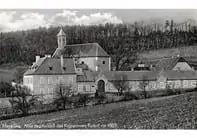Crown Prince Rudolf – he sought his happiness with women and in death
Crown Prince Rudolf Franz Karl Joseph von Habsburg, his full name, was born in Laxenburg on August 21, 1858. What was his short life like and which women did he love? Why does his death remain a mystery to this day
Crown Prince Rudolf (1858-1889) was the only son and thus heir to the throne. However, he did not become a ruling member of the Habsburg dynasty and is regarded as a tragic figure of the declining monarchy. Unlike his father, Emperor Franz Joseph, he had progressive ideas that he was unable to put into practice. He also indulged in the Viennese nightlife and had numerous lovers in addition to his wife, the Belgian royal daughter Stephanie. Together they had a daughter named Elisabeth-Marie.
The only son of Emperor Franz Joseph and Elisabeth (Sisi) was subjected to the military drill of his tutor Leopold Gondrecourt from the age of six. He was to be “hardened” to make him a good soldier. For example, he was woken up with pistol shots or left alone in the forest until his mother Elisabeth intervened and this type of training was discontinued.
Instead, his scientific interests were encouraged and he enjoyed a liberal and bourgeois education from Count Latour and other teachers. He was regarded as an intelligent child with a quick grasp of things. His ornithological interests later even earned him an honorary doctorate from the University of Vienna.
He was often in conflict with his father due to his views. He was considered sensitive, liberal, anti-clerical and very critical of the multi-ethnic monarchy. He believed in the power of the bourgeoisie and, like his mother, rejected courtly society. Nevertheless, he also had a rather distant relationship with his mother.
He wrote many of his thoughts under a different name in Moritz Szeps’ Neues Wiener Tagblatt. His friendship with Jewish intellectuals was not welcomed at court and isolated him more and more, which also had an effect on his mental state.
In 1881, the arranged marriage to Princess Stephanie, daughter of the Belgian King Leopold II, took place. Two years later, their only daughter Elisabeth Marie was born. The marriage cannot be described as happy, as Rudolf sought his fortune with other women. He traveled with his mistress for courtship and this continued into the marriage, where he had contact with prostitutes.
He took refuge in alcohol and drugs, suffered from depression and his health deteriorated due to his lifestyle and the consequences of a sexually transmitted disease (probably gonorrhea).
He saw suicide as the only way out, but he did not want to go it alone. His companion at the time, the 17-year-old Baroness Mary Vetsera, was prepared to go with him. On January 30, 1889, he put an end to both their lives with the shots fired at Mayerling. The Mayerling tragedy has not yet been fully explained.
The small community of Mayerling is considered one of the most dramatic places in the Vienna Woods. More than 100,000 visitors come to the Carmelite monastery, which now stands on the site of the hunting lodge. The crime is said to have taken place where the altar of the chapel is now located.
Three years earlier, Rudolf had bought the estate in Mayerling and had it converted into a small hunting lodge. Hunting was a popular pastime for the Habsburgs. Such a casual hunting trip was also suspected when Rudolf set off for Mayerling in January 1889. But one day after his arrival, the fatal pistol shots were fired.
Crown Prince Rudolf, the heir to the throne, the hope of the dynasty and the empire, is dead – so wrote the Neue Freie Presse in the evening edition of January 30, 1889. The whole country was in an uproar. At first it was assumed that it was an accident, but soon rumors spread of murder and suicide, even a love death.
The imperial family tried to cover up the alleged suicide and murder. As a suicide, Rudolf was not even entitled to a church funeral. A medical certificate was issued attesting to the crown prince’s insanity. It was clearly a “courtesy report”.
But how was the murder of Mary Vetsera explained? She was accused of suicide in a fictitious corpse report and secretly buried in the cemetery at Heiligenkreuz Abbey. She was placed in a hackney carriage with her clothes on and a stick stuck in her dress so that she would not fall over during the cover-up.
The exact circumstances of Rudolf and Mary Vetsera’s death have not yet been fully clarified and are still the subject of speculation. According to the current state of knowledge, it is assumed that Rudolf, who was plagued by depression, first shot his lover Mary Vetsera and then killed himself with a shot to the head.
Ultimately, this incident shook confidence in the Habsburg monarchy. For Elisabeth, the death of her son was an extreme turning point in her life. She was now only seen dressed in black, she suffered from depression and was already longing for her own death. She traveled restlessly throughout Europe and escaped into a dream world.
Tip from Sisi’s Amazing JourneyCombine a trip to Mayerling with a visit to the Cistercian monastery of Heiligenkreuz, located in the middle of the Vienna Woods. Afterwards, you can also visit the spa town of Baden. These places are no more than 1 hour away from Vienna.

